 Now then, seems the old perennial adage ‘many years ago’ has crept up again and today I find myself celebrating Mallard’s record breaking run when she thundered down the East Coast Mainline and set the record for steam powered haulage back in 1938. It was mentioned, in passing, in ‘Complicated doings at Sackville Lodge’, but today, 3rd July 2013 is the 75th Anniversary and much is going on, including a gathering of the all the surviving Gresley A4s at The National Railway Museum at York. Must see if we can have a day off.
Now then, seems the old perennial adage ‘many years ago’ has crept up again and today I find myself celebrating Mallard’s record breaking run when she thundered down the East Coast Mainline and set the record for steam powered haulage back in 1938. It was mentioned, in passing, in ‘Complicated doings at Sackville Lodge’, but today, 3rd July 2013 is the 75th Anniversary and much is going on, including a gathering of the all the surviving Gresley A4s at The National Railway Museum at York. Must see if we can have a day off.
 Back to the adage then and, when I was very small, I went with me dad to the Kings Cross engine sheds. I forget who organised the visit but it was brilliant. It was possibly 1961 and steam, but if it knew, was well in its twilight years. In the smoky environs of the shed and sidings was Silver Fox, one of the four original Gresley A4s built in 1935, a fantastic streamlined engine then in British Railways livery and numbered accordingly, well in steam, waiting to take its leave and, so my dad told me, back onto the afternoon Edinburgh train, one of the most iconic LNER services ever. The Gresley A4 was my favourite (still is) and surely every boys’ picture book engine. Designed by Sir Nigel Gresley and built in Doncaster as revolutionary crack LNER express engines, the A4s caused a balanced mix of incredulity and amazement when they first took to the rails in the mid thirties.
Back to the adage then and, when I was very small, I went with me dad to the Kings Cross engine sheds. I forget who organised the visit but it was brilliant. It was possibly 1961 and steam, but if it knew, was well in its twilight years. In the smoky environs of the shed and sidings was Silver Fox, one of the four original Gresley A4s built in 1935, a fantastic streamlined engine then in British Railways livery and numbered accordingly, well in steam, waiting to take its leave and, so my dad told me, back onto the afternoon Edinburgh train, one of the most iconic LNER services ever. The Gresley A4 was my favourite (still is) and surely every boys’ picture book engine. Designed by Sir Nigel Gresley and built in Doncaster as revolutionary crack LNER express engines, the A4s caused a balanced mix of incredulity and amazement when they first took to the rails in the mid thirties.
Fully streamlined and never rebuilt the first engines were all prefixed by the word ‘Silver’, liveried in silver and hauled matching silver streamlined carriages. They were brilliant space age things that slashed travelling times to the north and were designed to run non-stop at full tilt boogey, economically, with a single tender picking up water from special troughs. Thirty five of these futuristic engines were built. With three cylinders they came in at around 167 tons with the tender loaded with 5000 gallons of water and 8 tons of coal. Designed to run at 90mph they could thunder non-stop to Scotland and were loved by their crews for their easy running. They were never surpassed, not even by the diesels that superceded them. Flash Gordon eat your heart out!
 The second batch were named after birds (Gresley was a keen bird-watcher) and it was one of these, Mallard, then four months old and fitted with the new double Kylchap chimney, that took the record for a steam hauled train, unbroken to this day, and entered the realm of common language. Now, Mallard’s run was set up and was, from the word go, staged as a record attempt to demonstrate that the LNER knew how to build engines and operate a truly fast service.
The second batch were named after birds (Gresley was a keen bird-watcher) and it was one of these, Mallard, then four months old and fitted with the new double Kylchap chimney, that took the record for a steam hauled train, unbroken to this day, and entered the realm of common language. Now, Mallard’s run was set up and was, from the word go, staged as a record attempt to demonstrate that the LNER knew how to build engines and operate a truly fast service. 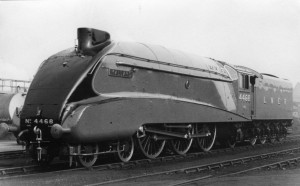 The run was initially claimed to be a test for the new Westinghouse brakes that had been fitted and the crew were not told about the record attempt until they boarded. So it was that on the 3rd July 1938 it shot past Kelsby hauling 240 tons, piloted by driver Duddington and fireman Bray. 125mph was recorded in the dynamometer car. It did record 126mph but Gresley disputed this stating that it could only have been for a few yards at best. Whatever the speed, it broke the existing German record of 124.5mph. It was a fantastic achievement but in doing so the centre cylinder big end gave out and by the time it reached Peterborough it was well poorly and was towed, somewhat indignantly, back to Kings Cross by an Ivatt.
The run was initially claimed to be a test for the new Westinghouse brakes that had been fitted and the crew were not told about the record attempt until they boarded. So it was that on the 3rd July 1938 it shot past Kelsby hauling 240 tons, piloted by driver Duddington and fireman Bray. 125mph was recorded in the dynamometer car. It did record 126mph but Gresley disputed this stating that it could only have been for a few yards at best. Whatever the speed, it broke the existing German record of 124.5mph. It was a fantastic achievement but in doing so the centre cylinder big end gave out and by the time it reached Peterborough it was well poorly and was towed, somewhat indignantly, back to Kings Cross by an Ivatt. 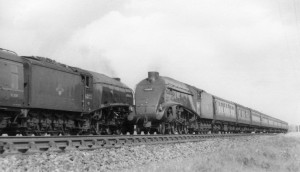 A4s had initially been noted for overheating the centre cylinder big end if really pushed but were generally very reliable, consistently fast, runners. A redesign of the centre cylinder and its valve gear soon eradicated the problem and they became, without doubt, the fastest and most reliable of all the steam engines that ran regularly on British lines. A second attempt at the speed record had been planned for 1939 but the outbreak of the War put an end to that.
A4s had initially been noted for overheating the centre cylinder big end if really pushed but were generally very reliable, consistently fast, runners. A redesign of the centre cylinder and its valve gear soon eradicated the problem and they became, without doubt, the fastest and most reliable of all the steam engines that ran regularly on British lines. A second attempt at the speed record had been planned for 1939 but the outbreak of the War put an end to that.
 Awesome performance and phenomenal power remained their trademark and records were continually set until their final withdrawal in the mid sixties. A few years after her record run Mallard pulled 390 tons up Stoke Bank (1:200) at a constant 80mph. This remarkable feat meant she was producing nearly 2500 drawbar horsepower, far more than during her record breaking run. Another, Capacaillie (renamed Charles H Newton in 1942), pulled 21 coaches, a train weight of 730 tons gross, just shy of 76 mph for 25 miles.
Awesome performance and phenomenal power remained their trademark and records were continually set until their final withdrawal in the mid sixties. A few years after her record run Mallard pulled 390 tons up Stoke Bank (1:200) at a constant 80mph. This remarkable feat meant she was producing nearly 2500 drawbar horsepower, far more than during her record breaking run. Another, Capacaillie (renamed Charles H Newton in 1942), pulled 21 coaches, a train weight of 730 tons gross, just shy of 76 mph for 25 miles.
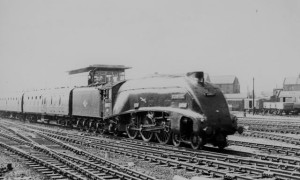 Back then to Silver Fox. These first A4s were regulars hauling, amongst others, The Silver Jubilee from London to Newcastle and The Elizabethan, a non-stop seven, later eight, coach streamlined train running between Edinburgh and London. With two crews and a corridor tender, the 400 mile journey was timetabled at six and half hours. They were noted for being on time and a great film called, appropriately enough, Elizabethan Express showed Silver Fox in all her splendour. On 27th August 1936 with driver George Haygreen and fireman C. Fisher and with a gross train weight approaching 400 tons a scheduled service run was organised to measure coal and water consumption and so, with the famous dynamometer car coupled up, they set off. No one had mentioned anything about a record speed attempt to the crew but despite approaching the summit of Stoke Bank under speed and with low boiler pressure they pushed it to 113mph beating the then current record held by Silver Link, its sister engine. Despite suffering big end damage to the centre cylinder it arrived at Kings Cross only seven minutes late. To this day Silver Fox is still the official holder of the fastest steam hauled train in revenue-earning service.
Back then to Silver Fox. These first A4s were regulars hauling, amongst others, The Silver Jubilee from London to Newcastle and The Elizabethan, a non-stop seven, later eight, coach streamlined train running between Edinburgh and London. With two crews and a corridor tender, the 400 mile journey was timetabled at six and half hours. They were noted for being on time and a great film called, appropriately enough, Elizabethan Express showed Silver Fox in all her splendour. On 27th August 1936 with driver George Haygreen and fireman C. Fisher and with a gross train weight approaching 400 tons a scheduled service run was organised to measure coal and water consumption and so, with the famous dynamometer car coupled up, they set off. No one had mentioned anything about a record speed attempt to the crew but despite approaching the summit of Stoke Bank under speed and with low boiler pressure they pushed it to 113mph beating the then current record held by Silver Link, its sister engine. Despite suffering big end damage to the centre cylinder it arrived at Kings Cross only seven minutes late. To this day Silver Fox is still the official holder of the fastest steam hauled train in revenue-earning service.
 Now, not to belittle the other A4s that were in service, many got pretty close to that record. Silver Link clocked a close 112.5 mph at least twice and then maintained over a 100 mph for 43 miles. Not bad. Put in context, most express services ran to around 75mph and the mainline was generally regarded as only good for 90mph. This was the age of romance and speed for the railways and the northern services were the ones that did it. Sure enough the Western Region had powerful engines but their romance lay in the services to Devon and Cornwall and with services like the Cornish Riviera Express they never had the chance to stretch their legs as the LNER engines did on the East Coast Main Line.
Now, not to belittle the other A4s that were in service, many got pretty close to that record. Silver Link clocked a close 112.5 mph at least twice and then maintained over a 100 mph for 43 miles. Not bad. Put in context, most express services ran to around 75mph and the mainline was generally regarded as only good for 90mph. This was the age of romance and speed for the railways and the northern services were the ones that did it. Sure enough the Western Region had powerful engines but their romance lay in the services to Devon and Cornwall and with services like the Cornish Riviera Express they never had the chance to stretch their legs as the LNER engines did on the East Coast Main Line.
When the Second World War came the Kings Cross engines were put into storage but by the end all had been repainted black and re-entered service performing well but with the streamlined panels that covered the running gear removed to improve servicing of the valve gear which were never replaced. Only one, Sir Ralph Wedgewood was lost, during a raid on York when the engine shed (now the National Railway Museum) received a direct hit, but the tender survived and continued in service. Now you may think that after the war they faded away, but not so. Always comparatively frugal on coal they got a make-over and the double blastpipe chimney was fitted to them all which improved efficiency even more, reportedly saving six to seven pounds of coal per mile ensuring that they remained the fastest and most economical steam engines in regular service. Although newer Pacifics had been introduced since the war, and despite the fact that the streamlined train service was never reinstated, the A4s continued on top link express duties, notably London to Edinburgh until their withdrawal.
 If you have any doubts about their power, in 1959 hauling a Stephenson Special with a substantial load, Sir Nigel Gresley thundered down Stoke Bank at a very impressive 112mph with driver Bill Hoole at the controls. On the footplate that day was Alan Pegler best known for his rescue of Flying Scotsman. Bill seemed set on smashing Mallards record but Pegler ‘advised’ him to ‘back off’ knowing the dangers of destroying the centre cylinder big end and the likely high bill never mind the state of the track! This then was the highest post war steam record. Whoa! Mind you, in the closing days of steam many engines were pushed to their limit ‘just to see’ and speeds of well over 100 mph were relatively commonplace, but seldom authenticated. Trawling through the reports there is actually an unconfirmed story that on arrival at King’s Cross with a late-running express the driver and fireman of Silver Fox were immediately suspended for two weeks for having been clocked at 130 mph on Stoke Bank. Now there’s a nice thought.
If you have any doubts about their power, in 1959 hauling a Stephenson Special with a substantial load, Sir Nigel Gresley thundered down Stoke Bank at a very impressive 112mph with driver Bill Hoole at the controls. On the footplate that day was Alan Pegler best known for his rescue of Flying Scotsman. Bill seemed set on smashing Mallards record but Pegler ‘advised’ him to ‘back off’ knowing the dangers of destroying the centre cylinder big end and the likely high bill never mind the state of the track! This then was the highest post war steam record. Whoa! Mind you, in the closing days of steam many engines were pushed to their limit ‘just to see’ and speeds of well over 100 mph were relatively commonplace, but seldom authenticated. Trawling through the reports there is actually an unconfirmed story that on arrival at King’s Cross with a late-running express the driver and fireman of Silver Fox were immediately suspended for two weeks for having been clocked at 130 mph on Stoke Bank. Now there’s a nice thought.
As diesel power took over in the sixties the beautiful Gresley A4s were gradually withdrawn from service. The last to go were Bittern in June 1966, now preserved, and Kingfisher in September 1966. Sadly on inspection the frames and the general state of Kingfisher meant she ended up being scrapped. 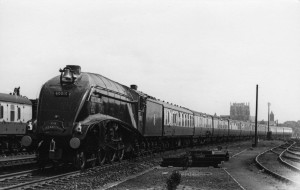 Today six engines remain. Bittern, Mallard, Sir Nigel Gresley (after the great man himself), Union of South Africa (Formally Osprey), Dominion of Canada (formally Woodcock) and Dwight D Eisenhower (formally Golden Shuttle). Silver Fox was scrapped in 1963 but one name plate and one fox emblem survive at York Railway Museum where they are usually on display. Mallard requires a new boiler certificate and is now restored with her streamlining panels over the running gear and is currently on display at The National Railway Museum, York. Sir Nigel Gresley (North York Moors Railway), Bittern (Mid-Hants Railway) and Union of South Africa, which is normally resident on the Severn Valley Railway, are all in mainline condition. Dwight D Eisenhower is normally on static display in Wisconsin USA and Dominion of Canada, also on static display, is kept at the Canadian Railway Museum in Canada.
Today six engines remain. Bittern, Mallard, Sir Nigel Gresley (after the great man himself), Union of South Africa (Formally Osprey), Dominion of Canada (formally Woodcock) and Dwight D Eisenhower (formally Golden Shuttle). Silver Fox was scrapped in 1963 but one name plate and one fox emblem survive at York Railway Museum where they are usually on display. Mallard requires a new boiler certificate and is now restored with her streamlining panels over the running gear and is currently on display at The National Railway Museum, York. Sir Nigel Gresley (North York Moors Railway), Bittern (Mid-Hants Railway) and Union of South Africa, which is normally resident on the Severn Valley Railway, are all in mainline condition. Dwight D Eisenhower is normally on static display in Wisconsin USA and Dominion of Canada, also on static display, is kept at the Canadian Railway Museum in Canada.
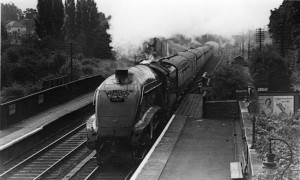 So, while I salute the 75th anniversary of Mallard’s record breaking run with a pint or two I salute all the A4s, especially Silver Fox and the man, Sir Nigel Gresley himself, for coming up with an unsurpassed design for an express locomotive. I will never forget seeing Silver Fox up close and touching the decidedly warm stainless steel Fox that adorned her, as all small boys did.
So, while I salute the 75th anniversary of Mallard’s record breaking run with a pint or two I salute all the A4s, especially Silver Fox and the man, Sir Nigel Gresley himself, for coming up with an unsurpassed design for an express locomotive. I will never forget seeing Silver Fox up close and touching the decidedly warm stainless steel Fox that adorned her, as all small boys did. 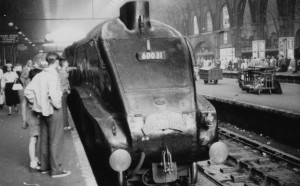 She still holds the record for the fastest steam hauled passenger train and I guess that will stand for a long time. When they were small we took the kids to see Sir Nigel Gresley as she thundered down the straight towards Haddenham pulling a long line of coaches, her eerie Chime whistle still audible long after the last wisps of steam and smoke had drifted away across the fields. I wonder if it was like that at Kelsby all those years ago?
She still holds the record for the fastest steam hauled passenger train and I guess that will stand for a long time. When they were small we took the kids to see Sir Nigel Gresley as she thundered down the straight towards Haddenham pulling a long line of coaches, her eerie Chime whistle still audible long after the last wisps of steam and smoke had drifted away across the fields. I wonder if it was like that at Kelsby all those years ago?
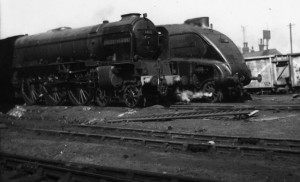 Footnote. Now, somewhere there were pictures of Silver Fox taken during our visit to Kings Cross Sheds but the only one I can find is one showing 60115 Meg Merrilies, a Peppercorn A1, and if you think it looks familiar, this is the same type as the recently built Tornado. Behind is Gresley A4 Guillemot which was probably preparing for a Newcastle run seeing as she was based there. Guillemot was scrapped at Doncaster in 1964. Now thanks to the power of the interweb, and the AI Steam Locomotive Trust, Meg Merrilies career is well documented and she was a regular visitor to Kings Cross in the early sixties. The picture of the two A4s passing is amazing as its two of the survivors whilst still in service, Mallard and Golden Shuttle, renamed Dwight D Eisenhower. The engine hauling The Elizabethan is Woodcock which became The Dominion of Canada which is why she sports a Canadian Pacific Railway type bell which was removed when the new chimney was fitted and has only recently been refitted. Third picture down shows Mallard gently steaming having been reversed and gently simmering prior to the record breaking run immediately behind the tender is the LNER dynamometer car. The blokes in bowlers are most likely from Westinghouse, whilst climbing into the cab is driver Duddington. The staff and recorders were offered a taxi to Grantham but they all declined. Minutes later Duddington eased the regulator open and Mallard moved into the history books. I reckon this is probably the most evocative picture of Mallard ever taken.
Footnote. Now, somewhere there were pictures of Silver Fox taken during our visit to Kings Cross Sheds but the only one I can find is one showing 60115 Meg Merrilies, a Peppercorn A1, and if you think it looks familiar, this is the same type as the recently built Tornado. Behind is Gresley A4 Guillemot which was probably preparing for a Newcastle run seeing as she was based there. Guillemot was scrapped at Doncaster in 1964. Now thanks to the power of the interweb, and the AI Steam Locomotive Trust, Meg Merrilies career is well documented and she was a regular visitor to Kings Cross in the early sixties. The picture of the two A4s passing is amazing as its two of the survivors whilst still in service, Mallard and Golden Shuttle, renamed Dwight D Eisenhower. The engine hauling The Elizabethan is Woodcock which became The Dominion of Canada which is why she sports a Canadian Pacific Railway type bell which was removed when the new chimney was fitted and has only recently been refitted. Third picture down shows Mallard gently steaming having been reversed and gently simmering prior to the record breaking run immediately behind the tender is the LNER dynamometer car. The blokes in bowlers are most likely from Westinghouse, whilst climbing into the cab is driver Duddington. The staff and recorders were offered a taxi to Grantham but they all declined. Minutes later Duddington eased the regulator open and Mallard moved into the history books. I reckon this is probably the most evocative picture of Mallard ever taken.
Huge thanks to me dad Jim Dunkley (God bless him) and Noel Loxley for pictures from his extensive collection more of which we will feature later no doubt.
http://www.lner.info/locos/A/a4.shtml Good general history on the class and recordings of the Chime whistle.